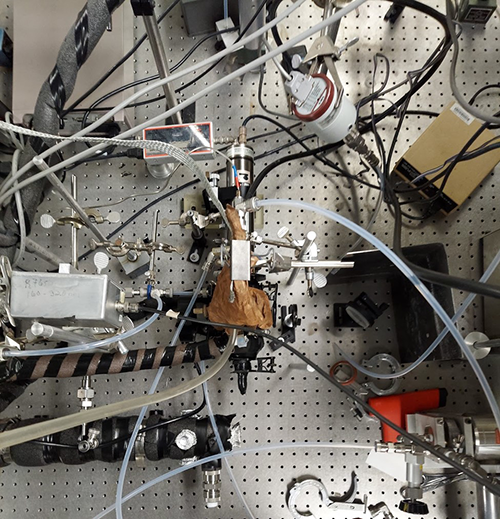Chemical Processes & Instrument Development: Instruments
Pulsed Laser Photolysis-Resonance Fluorescence (PLP-RF)



Principle of the Measurement
This method relies on the detection of emitted photons (fluorescence) from the relaxation of excited atomic nuclei upon excitation from a microwave discharge source. In general, PLP-RF is the principle method used to determine absolute rate coefficients for reactions of Cl-atoms with organic molecules of atmospheric interest. Pulsed laser photolysis, using an excimer laser, of a Cl-atom precursor produces Cl-atoms which then undergo reactions with organic molecules in a selected bath gas.The concentration of organic molecules, under pseudo first-order conditions with respect to Cl-atom, is varied to obtain the rate coefficient of the Cl-atom reaction.
Technical Specifications
Species Measured: Detection of atomic species (N, O, Cl, F, H)
Reaction Time: microsecond to 40 millisecond
Analytical Sensitivity: for Cl-atom
- ~108 atoms cm-3 (He)
- ~109 atoms cm-3 (N2)
Applications
Reaction rate coefficient measurements over a range of temperature and pressure, photolysis quantum yields
Key Publications
Ghosh, B., D.K. Papanastasiou, and J.B. Burkholder, Oxalyl Chloride, ClC(O)C(O)Cl: UV/vis Spectrum and Cl atom photolysis quantum yields at 193, 248, and 351 nm, Journal of Chemical Physics, doi:10.1063/1.4755769, 2012.
Papanastasiou, D.K., K.J. Feierabend, and J.B. Burkholder, Cl2O photochemistry: Ultraviolet/vis absorption spectrum temperature dependence and O(3P) quantum yield at 193 and 248 nm, Journal of Chemical Physics, doi:10.1063/1.3592662, 2011.